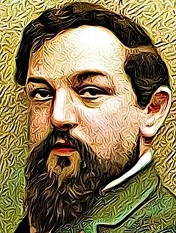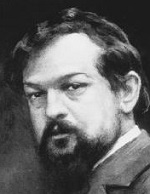Claude Debussy
Claude Debussy, in full Achille-Claude Debussy, (born August 22, 1862 — died March 25, 1918), was a French composer whose works were a seminal force in the music of the 20th century.
He developed a highly original system of harmony and musical structure that expressed in many respects the ideals to which the Impressionist and Symbolist painters and writers of his time aspired.
His major works include Clair de lune, Prélude à l’après-midi d’un faune, the opera Pelléas et Mélisande, and La Mer.
Early period
Debussy showed a gift as a pianist by the age of nine.
He was encouraged by Madame Mauté de Fleurville, who was associated with the Polish composer Frédéric Chopin, and in 1873 he entered the Paris Conservatory, where he studied the piano and composition, eventually winning 1884 the Grand Prix de Rome with his cantata L’Enfant prodigue.
Debussy’s youth was spent in circumstances of great turbulence.
He was almost overwhelmed by situations of great extremes, both material and emotional. 
While living with his parents in a poverty-stricken suburb of Paris, he unexpectedly came under the patronage of a Russian millionairess, Nadezhda Filaretovna von Meck, who engaged him to play duets with her and her children.
He traveled with her to her palatial residences throughout Europe during the long summer vacations at the Conservatory.
In Paris during this time he fell in love with a singer, Blanche Vasnier, the beautiful young wife of an architect; she inspired many of his early works.
It is clear that he was torn by influences from many directions; these stormy years, however, contributed to the sensitivity of his early style.
This early style is well illustrated in one of Debussy’s best-known compositions, Clair de lune.
The title refers to a folk song that was the conventional accompaniment of scenes of the lovesick Pierrot in the French pantomime, and indeed the many Pierrot-like associations in Debussy’s later music, notably in the orchestral work Images (1912) and the Sonata for Cello and Piano (1915; originally titled Pierrot fâché avec la lune [“Pierrot Vexed by the Moon”]), show his connections with the circus spirit that also appeared in works by other composers, notably the ballet Petrushka (1911) by Igor Stravinsky and Pierrot Lunaire by Arnold Schoenberg.
Middle period
As a holder of the Grand Prix de Rome, Debussy was given a three-year stay at the Villa Medici in Rome, where, under what were supposed to be ideal conditions, he was to pursue his creative work.
 Most composers who were granted this state scholarship, however, found life in this magnificent Renaissance palace irksome and longed to return to simpler and more familiar surroundings.
Most composers who were granted this state scholarship, however, found life in this magnificent Renaissance palace irksome and longed to return to simpler and more familiar surroundings.
Debussy himself eventually fled from the Villa Medici after two years and returned to Blanche Vasnier in Paris.
Several other women, some with a doubtful reputation, were also associated with him in his early years.
At this time Debussy lived a life of extreme indulgence.
Once one of his mistresses, Gabrielle (“Gaby”) Dupont, threatened suicide.
His first wife, Rosalie (“Lily”) Texier, a dressmaker, whom he married in 1899, did in fact shoot herself, though not fatally, and, as is sometimes the case with artists of passionate intensity, Debussy himself was haunted by thoughts of suicide.
The main musical influence in Debussy’s work was the work of Richard Wagner and the Russian composers Aleksandr Borodin and Modest Mussorgsky.
Wagner fulfilled the sensuous ambitions not only of composers but also of the Symbolist poets and the Impressionist painters.
Wagner’s conception of Gesamtkunstwerk (“total artwork”) encouraged artists to refine their emotional responses and to exteriorize their hidden dream states, often in a shadowy, incomplete form; hence the more tenuous nature of the work of Wagner’s French disciples.
It was in this spirit that Debussy wrote the symphonic poem Prélude à l’après-midi d’un faune (1894).
Other early works by Debussy show his affinity with the English Pre-Raphaelite painters; the most notable of these works is La Damoiselle élue (1888), based on “The Blessed Damozel” (1850), a poem by the English poet and painter Dante Gabriel Rossetti.
In the course of his career, however, which covered only 25 years, Debussy was constantly breaking new ground.
Explorations, he maintained, were the essence of music; they were his musical bread and wine.
His single completed opera, Pelléas et Mélisande (first performed in 1902), demonstrates how the Wagnerian technique could be adapted to portray subjects like the dreamy nightmarish figures of this opera who were doomed to self-destruction.
Debussy and his librettist, Maurice Maeterlinck, declared that they were haunted in this work by the terrifying nightmare tale of Edgar Allan Poe, The Fall of the House of Usher.
The style of Pelléas was to be replaced by a bolder, more highly colored manner.
In his seascape La Mer (1905) he was inspired by the ideas of the English painter J.M.W. Turner and the French painter Claude Monet.
In his work, as in his personal life, he was anxious to gather experience from every region that the imaginative mind could explore.
Late period
In 1905 Debussy’s illegitimate daughter, Claude-Emma was born.
He had divorced Lily Texier in 1904 and subsequently married his daughter’s mother, Emma Bardac.
Repelled by the gossip and scandal arising from this situation, he sought refuge for a time at Eastbourne, on the south coast of England.
For his daughter, nicknamed Chouchou, he wrote the piano suite Children’s Corner (1908).
Debussy’s spontaneity and the sensitive nature of his perception facilitated his acute insight into the child mind, an insight noticeable particularly in Children’s Corner, a French counterpart to Mussorgsky’s song cycle The Nursery; in the Douze Préludes, 2 books (1910, 1913; “Twelve Preludes”), for piano; and in the ballet La Boîte à joujoux (first performed in 1919; The Box of Toys).
In his later years, it is the pursuit of illusion that marks Debussy’s instrumental writing, especially the strange, other-worldly Cello Sonata.
This noble bass instrument takes on, in chameleon fashion, the character of a violin, a flute, and even a mandolin.
Debussy was developing in this work ideas of an earlier period, those expressed in a youthful play he had written, Frères en art (Brothers in Art), where his challenging, indeed anarchical, ideas are discussed among musicians, painters, and poets.
(He had in fact published in one of the anarchist journals poems that he had written and that he later set to music in the song cycle Proses lyriques [1893].)
Evolution of his work
Debussy’s music marks the first of a series of attacks on the traditional language of the 19th century.
He did not believe in the stereotyped harmonic procedures of the 19th century, and indeed it becomes clear from a study of mid-20th-century music that the earlier harmonic methods were being followed in an arbitrary, academic manner.
Hence his formulation of the “21-note scale” was designed to “drown” the sense of tonality, though this system was never adhered to in the inflexible manner of the 12-note system of Schoenberg.
Debussy’s inquiring mind similarly challenged the traditional orchestral usage of instruments.
He rejected the traditional dictum that string instruments should be predominantly lyrical.
The pizzicato scherzo from his String Quartet (1893) and the symbolic writing for the violins in La Mer, conveying the rising storm waves, show a new conception of string color.
Similarly, he saw that woodwinds need not be employed for fireworks displays; they provide, like the human voice, a wide variety of colors.
Debussy also used brass in original color transformations.
In fact, in his music, the conventional orchestral construction, with its rigid woodwind, brass, and string departments, finds itself undermined or split up in the manner of the Impressionist painters.
Ultimately, each instrument becomes almost a soloist, as in a vast chamber-music ensemble.
Finally, Debussy applied an exploratory approach to the piano, the evocative instrument par excellence since notes struck at the keyboard are, by the nature of the piano mechanism, neither eighth notes, quarter notes, nor half notes, but merely illusions of these notes.
During the latter part of his life, Debussy created an alter ego, “Monsieur Croche,” with whom he carried on imaginary conversations on the nature of art and music.
“What is the use of your almost incomprehensible art?” Monsieur Croche asks. “Is it not more profitable to see the sunrise than to listen to the Pastoral Symphony of Beethoven?”
Elsewhere Monsieur Croche supports the cause of the musical explorer: “I am less interested in what I possess than in what I shall need tomorrow.”
In his last works, the piano pieces En blanc et noir, (1915; In Black and White) and in the Douze Études (1915; “Twelve Études”), Debussy had branched out into modes of composition later to be developed in the styles of Stravinsky and the Hungarian composer Béla Bartók.
It is certain that he would have taken part in the leading movements in the composition of the years following World War I had his life not been so tragically cut short by cancer.
Wagner, said Debussy, was a wonderful sunset that had been mistaken for a dawn.
As one looks back on the music of the last century this seems a remarkably shrewd observation.
It was true of Wagner, of course, but it is now seen to be more true of Debussy himself.
The fact is that there comes a time when the peak, the zenith of civilization is reached.
Critics have frequently noted this evolutionary stage in the music of Wagner, Debussy, or one of their followers.
A quintessential spirit is presented by these composers, and it seemed at the time that they could never be surpassed.
But of course, it is at this very stage that a decline in musical values sets in. Hence the paradoxical element in Debussy’s stature.
Undoubtedly, he was aware of this duality in his achievement, as may be gathered from his searching, hesitant letters.
Sensitive to sham in every sphere and also a child of his environment, he not only perceived this dual aspect of his work but also realized the extent to which he himself was caught up in this vast evolutionary transformation.
Debussy’s work cannot be judged on the musical level alone.
“One must seek the poetry in his work,” said his friend the French composer Paul Dukas.
There is not only poetry in his music; there is often inspiration from painting.
“I love painting [les images, a generic term that might apply to the whole of Debussy’s work] almost as much as the music itself,” he told the Franco-American composer Edgard Varèse.
This association of the arts is a theme that runs through the whole of the 19th century—it originated with the theories of the German short-story writer E.T.A. Hoffmann—but for Debussy, it was a theory more sensitively expressed in the tales of Edgar Allan Poe.
Throughout his life Debussy planned to set The Fall of the House of Usher in the form of an opera—the shadow of the tale never having been realized in Pelléas et Mélisande—and actually signed a contract for the production of this work at the Metropolitan Opera in New York City, but it was never completed.
The fact is that the hero of the tale, Roderick Usher, was a hypersensitive being like Debussy himself—a poet, a painter, and a musician.
Moreover, the reputation of Poe was, during Debussy’s life and after, almost entirely a French reputation.
The French poets translated his works, and the French painters appreciated his genius, and it was therefore only natural that a French musician should similarly have reflected the nature of his appeal.
–
Suite bergamasque (L. 75)
This piano suite Debussy began composing around 1890, at the age of 28, but significantly revised it just before its 1905 publication. The popularity of the 3rd movement, “Clair de lune“, has made it one of the composer’s most famous works for piano. Suite bergamasque consists of four movements:
Prélude (Moderato tempo rubato, F major), Menuet (Andante, A minor), Clair de lune (Andante très expressif, D♭ major), Passepied (Allegretto ma non troppo, F♯ minor).
In the video, the whole suite bergamasque is performed live by Pallavi Mahidhara at Rougemont.
1. Prélude
2. Menuet (4:35)
3. Clair de lune (9:25)
4. Passepied (14:30)
In this video, Debussy himself plays Clair de Lune (1913). This is a recording obtained by PIANO ROLL, More than one century old, these recordings allow us to listen to the great composer playing his own works.
Here is another video performance of Clair de Lune by pianist Pascal Rogé.
Here is a video of an arrangement of Clair de Lune for a symphony orchestra by André Caplet performed by the Frankfurt Radio Symphony Orchestra conducted by Jean-Christophe Spinosi.
This video presents another arrangement of Clair de Lune for a symphony orchestra by Stanley Black performed by the London Symphony Orchestra conducted by the arranger. All the paintings in the video are by the English painter John Atkinson Grimshaw.
–
La Mer (The Sea), L. 109
Composed between 1903 and 1905, the piece premiered in Paris in October 1905.
It was initially not well received. Even some who had been strong supporters of Debussy’s work were unenthusiastic, even though La Mer presented three key aspects of Debussy’s aesthetic: Impressionism, Symbolism, and Japonism.
But the work was performed in the US in 1907 and Britain in 1908; after its second performance in Paris, in 1908, it quickly became one of Debussy’s most admired and frequently performed orchestral works.
(00:49) 1. De l’aube à midi sur la mer (From dawn to noon on the sea)
(09:55) 2. Jeux de vagues (Play of the waves)
(16:39) 3. Dialogue du vent et de la Mer (Dialogue between wind and waves)
In the video, La Mer is performed by the Royal Concertgebouw Orchestra conducted by Bernard Haitink.
–
Prélude à l’après-midi d’un faune (L. 86)
This is known in English as Prelude to the Afternoon of a Faun. It is a symphonic poem for orchestra.
It was composed in 1894 and first performed in Paris on 22 December 1894, conducted by Gustave Doret.
The composition was inspired by the poem L’après-midi d’un faune by Stéphane Mallarmé.
It is one of Debussy’s most famous works and is considered a turning point in the history of Western art music.
Pierre Boulez considered the score to be the beginning of modern music, observing that “the flute of the faun brought new breath to the art of music.”
Debussy’s work later provided the basis for the ballet Afternoon of a Faun choreographed by Vaslav Nijinsky and a later version by Jerome Robbins.
In the video, the music is performed by the Frankfurt Radio Symphony Orchestra conducted by Andrés Orozco-Estrada.
–
Deux arabesques
Deux arabesques (Two Arabesques), L. 66, is a pair of arabesques composed for piano between the years 1888 and 1891.
Although quite an early work, the arabesques contain hints of Debussy’s developing musical style.
The suite is one of the very early impressionistic pieces of music, following the French visual art form.
Debussy seems to wander through modes and keys and achieves evocative scenes through music.
His view of a musical arabesque was a line curved in accordance with nature, and with his music, he mirrored the celebrations of shapes in nature made by the Art Nouveau artists of the time.
Of the arabesque in baroque music, he wrote: “That was the age of the ‘wonderful arabesque’ when music was subject to the laws of beauty inscribed in the movements of Nature herself.”
Arabesque No. 1 00:00
Arabesque No. 2 04:22
In the video, the music is performed by pianist Ronan O’Hora.
–
Estampes (“Prints”), L.100
This impressionistic suite for solo piano is in three movements. It was finished in 1903.
The first performance of the work was given by Ricardo Viñes at the Société Nationale de Musique in Paris.
1) Pagodes | 0:08 |
2) La Soirée dans Grenade | 5:57 |
3) Jardins sous la pluie | 11:12 |
In the video, the suite is performed by pianist Anna Zassimova.
–
Nocturnes, L. 91
This is an impressionist orchestral composition in three movements. Claude Debussy wrote it between 1892 and 1899. It is based on poems from Poèmes anciens et romanesques (Henri de Régnier, 1890).
In the video, the music is performed by l’Orchestre philharmonique de Radio France conducted by Mikko Franck.
0:47 Nuages
7:51 Fêtes
14:39 Sirènes
–
Rêverie
This is a piano piece written about 1895.
In the video, an arrangement for symphony orchestra is performed by l’Orchestre National de France conducted by Cristian Măcelaru.
–


